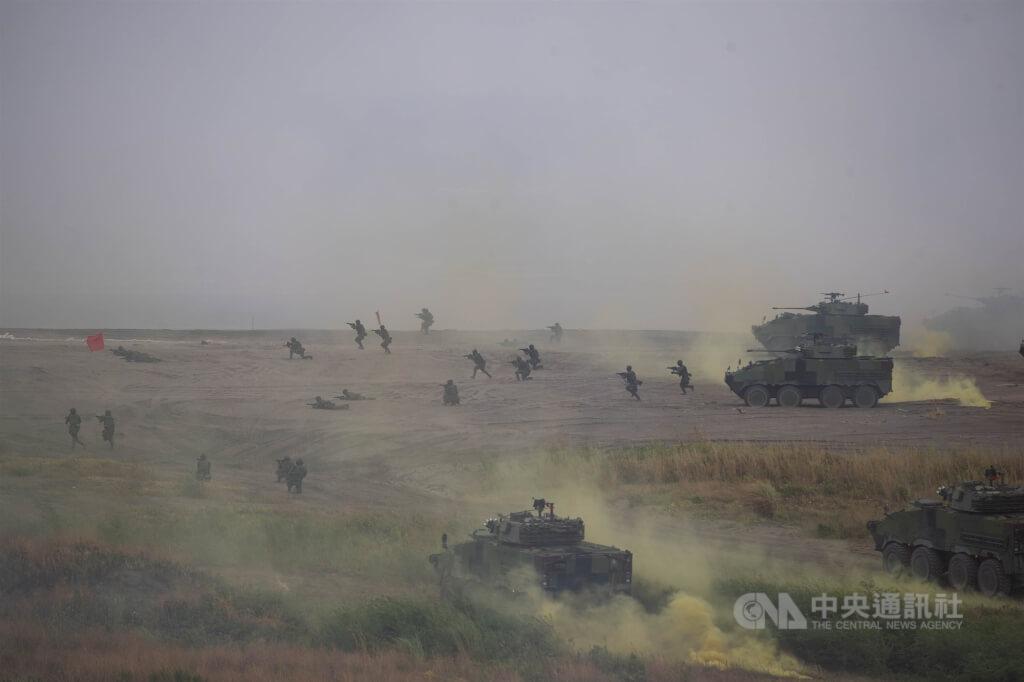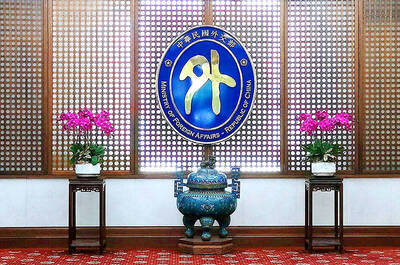A report released yesterday by US think tank Defense Priorities called on the US to withdraw all 500 US military training personnel currently stationed in Taiwan to avoid appearing “provocative” to China and contravening “past commitments not to base US forces on the island.”
“If training is truly needed, it can be provided in the [US],” it said.
Ahead of the US’ National Defense Strategy (NDS) 2025 draft, set to be released Aug. 31, the report suggested a strategic re-posturing that would remove 22,000 US military personnel from the Asia-Pacific region.

Photo: CNA
Titled “Aligning global military posture with U.S. interests," the report suggests shifting US operations from the first island chain to the second, recommending relocations to Guam and considering a shift to Palau and the Marshall Islands.
The 28-page report was authored by Dan Caldwell, former senior advisor to US Secretary of Defense Pete Hegseth before his suspension in April, and director of military analysis at US think tank Defense Priorities Jennifer Kavanagh.
The report states that the US should seek to establish “regional balancing,” as opposed to “regional dominance,” adding that Taiwan does not require direct US military defense as “the tiny island would not dramatically shift the balance of power.”
It stated that Taiwan has not yet invested enough in its own defense spending and the [US] has been “too willing to carry the additional burden.”
“Taiwan, though not an official US ally, has... come to assume that support from the [US] in the event the island is attacked by China is more or less assured,” it added.
The report has led to debate on social media platform X, with Michael Sobolik, a former legislative assistant in the US Senate, saying the report’s “analysis on Taiwan is just wrong.”
“Washington never fully committed to withdraw US forces from Taiwan without preconditions,” he said, adding that any withdrawal is “contingent on cross-strait relations,” according to the 1972 Communique.
Moreover, according to the Taiwan Relations Act, the US must provide adequate defense articles and defense services to enable Taiwan to maintain sufficient self-defense capabilities, Sobolik said.
Sobolik is a senior fellow at the Hudson Institute and was previously a senior fellow in Indo-Pacific studies at the American Foreign Policy Council.
The report also recommended reducing the number of US forces by half in South Korea, cutting personnel in Okinawa, transferring troops to Guam and further north in Japan, and refraining from sending any additional systems to the Philippines.
It further argued that the US should learn from mistakes made in Europe, where “constant revisions to US commitments" made to Russia that it would not expand NATO or NATO forces along Russia’s border “contributed to the current war in Ukraine.”

The Ministry of Foreign Affairs (MOFA) yesterday voiced dissatisfaction with the Comprehensive and Progressive Agreement for Trans- Pacific Partnership (CPTPP), whose latest meeting, concluded earlier the same day, appeared not to address the country’s application. In a statement, MOFA said the CPTPP commission had "once again failed to fairly process Taiwan’s application," attributing the inaction to the bloc’s "succumbing to political pressure," without elaborating. Taiwan submitted its CPTPP application under the name "Separate Customs Territory of Taiwan, Penghu, Kinmen and Matsu" on Sept. 22, 2021 -- less than a week after China

THE GOOD WORD: More than 100 colleges on both sides of the Pacific will work together to bring students to Taiwan so they can learn Mandarin where it is spoken A total of 102 universities from Taiwan and the US are collaborating in a push to promote Taiwan as the first-choice place to learn Mandarin, with seven Mandarin learning centers stood up in the US to train and support teachers, the Foundation for International Cooperation in Higher Education of Taiwan (FICHET) said. At the annual convention of the American Council on the Teaching of Foreign Languages held over the weekend in New Orleans, Louisiana, a Taiwan Pavilion was jointly run by 17 representative teams from the FICHET, the Overseas Community Affairs Council, the Steering Committee for the Test of Proficiency-Huayu, the

A home-style restaurant opened by a Taiwanese woman in Quezon City in Metro Manila has been featured in the first-ever Michelin Guide honoring exceptional restaurants in the Philippines. The restaurant, Fong Wei Wu (豐味屋), was one of 74 eateries to receive a “Michelin Selected” honor in the guide, while one restaurant received two Michelin stars, eight received one star and 25 were awarded a “Bib Gourmand.” The guide, which was limited to restaurants in Metro Manila and Cebu, was published on Oct. 30. In an interview, Feng Wei Wu’s owner and chef, Linda, said that as a restaurateur in her 60s, receiving an

Kaohsiung Mayor Chen Chi-mai (陳其邁) on Monday announced light shows and themed traffic lights to welcome fans of South Korean pop group Twice to the port city. The group is to play Kaohsiung on Saturday as part of its “This Is For” world tour. It would be the group’s first performance in Taiwan since its debut 10 years ago. The all-female group consists of five South Koreans, three Japanese and Tainan’s Chou Tzu-yu (周子瑜), the first Taiwan-born and raised member of a South Korean girl group. To promote the group’s arrival, the city has been holding a series of events, including a pop-up